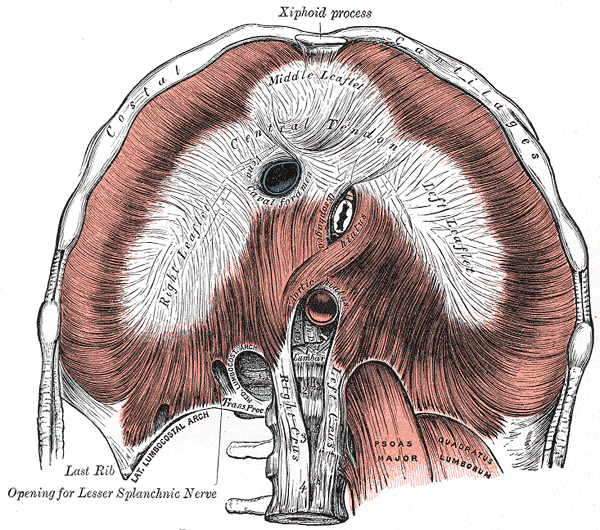The thoracic (breathing) diaphragm is a broad, thin, double domed muscle with insertions around the circumference of the lower rib cage, the spine, and the lower portion of the sternum. It spans the thoraco-abdominal cavity and contains a strong central tendon, the left and right parts of which insert into one another. The thoracic diaphragm is the main muscle of the breath, and it is said that its movement is responsible for 75% of the respiratory airflow. The accessory breathing muscles are responsible for the additional 25%.
The diaphragm separates the heart and lungs above from the abdominal organs below. The heart rests on the central tendon and is connected to it by the pericardium. The heart rises and falls with the movement of the diaphragm, as do the lungs. The diaphragm is the seat of the heart and lungs. It massages, rolls, and squeezes the abdominal organs as it moves. This movement contributes to health and suppleness in the organs as they are bathed in fresh blood and fluids.
An under-recognized and under used aspect of the diaphragm is its muscular stem. The stem, or crura, is widely considered to connect only about as far as the third lumbar vertebra; however, in Embodyoga® and Body-Mind-Centering® we have found that in full use, the support of the stem can be felt all the way to the coccyx. We feel it is important to develop the use of the diaphragm all the way to the tail because we consider it to be the primary muscular support of the lumbar spine. The stem of the breathing diaphragm blends with the anterior longitudinal ligament along the front of the spine. The effect of this muscular and ligamentous support along the front of the spine through the lumbar region is absolutely critical to full integration of upper and lower body in asana. Without the use of this strong vertical support there is often a break in the pranic flow from head-to- tail and tail-to-head. This effects our experience of “integration and unity” in the posture and compromises the integrity of the spine in the bargain. Continue reading

